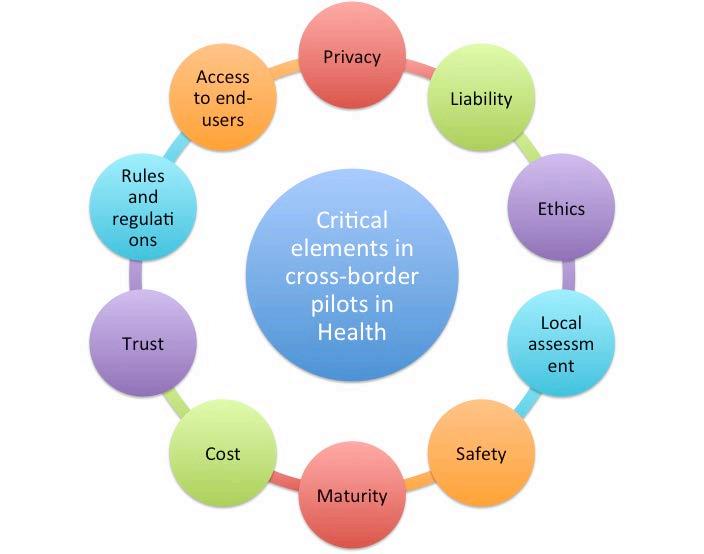
8 minute read
3. How Living Labs envision a thematic network
3. How Living Labs envision a thematic network During the APOLLON project we as WP2 have coordinated the survey onthe needs and demands of the Living Lab community with regard to a thematic structured approach. The full description of the results can be found in D6.6. In this section we will elaborate on the results related to the domain of Health and Well-Being.
The survey was deployed to all Living Labs that are a member of the ENoLL community, eg. 274 Living Labs. In total 48Living Labs have responded to the survey. The survey was constructed in such way that after a first general section, the Living Labs that have a specific focus in one of the Apollon domains (homecare and independent Living, Energy Efficieny, eManfucturing and eMedia)would be filtered to a specific subset of questions targeted to this domain. For what concerns health and homecare we see that 23Living Labs are active in the domain, but that –for those Living Labs that responded, 8 of them have a dominant focus on health and well-being. The results are based on their input.
Advertisement
3.1.2 Results
Figure 2. Overview of domains in which LL are active
Figure 3. Main focus of the Living Labs
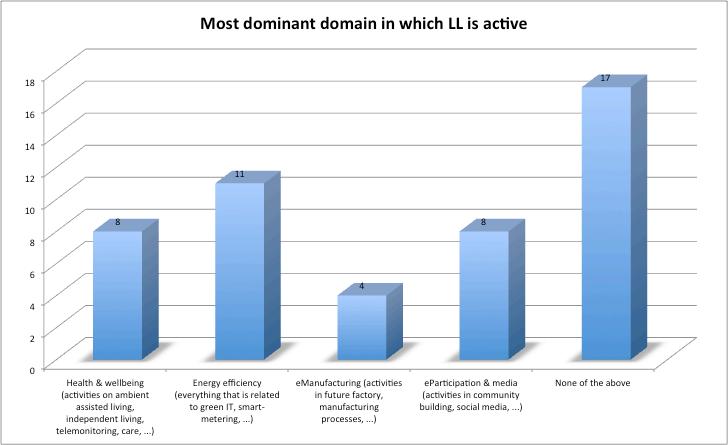
When looking at the subdomains of Health we do see that most Living Labs do have a broad focus but that independent livings as well as prevention arethe most important themes they are active in.
Figure 4. Domains in which the Health Living Labs are most active

Apollon –Deliverable D2.5 This is also reflected in the projects that are being deployedin the Living Labs. Beside these themes we do also notice that the Living Labs are active in Health records, robotics as well as on the cross-over with Energy.
Figure 5. Projects being performed in various health domains

But when we look at the interest of the Living Labs in health specific domains we do notice that there is a huge interest in mainly three topics: mobile health services, ambient assisted Living Systems and medical training (in a broad sense).
Figure 6. Overview of the health topics in which the Living Labs have an interest
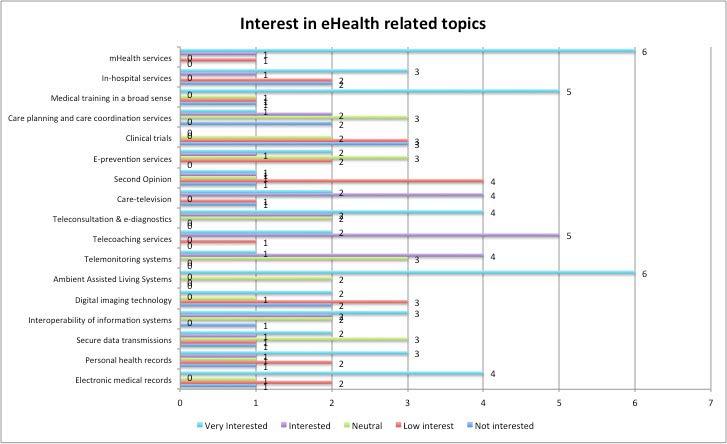
We also do see that the health Living Labs have performed projects that covers the wide spectrum of the health well-being domain. This implies that the Living Labs do not only have expertise in this domain but also that they have (access to) the necessary stakeholders to facilitate different types of projects.
Figure 7. The amount of projects performed in a specific health area
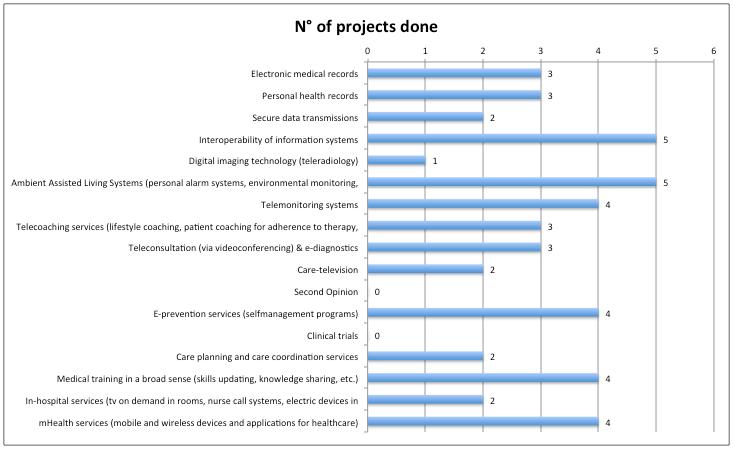
Apollon –Deliverable D2.5 The projects are mainly performed within a public-private partnership in which the triple helix of government, industrial actors and research institutes clearly is reflected.
Figure 8. Partners of the Living Lab and the type of collaboration
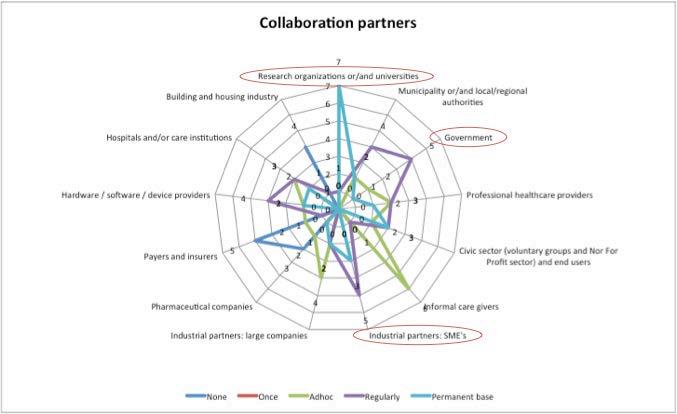
When investigating a domain thematic network of Living Labs we do see that all Living Labs agree that such initiative is perceived as useful and a necessity. Organizing this network should be best be done aspart of the European Network of Living Labs (as it is today). The participation to this networkhowever, should be ideally be free of charge.
Figure 9. Vision on a thematic network on health
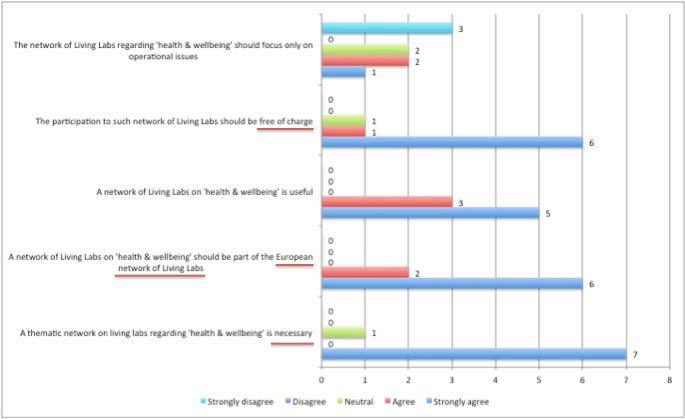
Within these operational focus there are three main aspects the network should focus on: • Relationship with users: How can you engageusers to be part of the Living Lab experiment? How do keep in touch and perform research activities with them? • Measurement instruments: Which instruments can be you used to facilitate specific research questions? For example how can you measure both economic and societal impact of eg.atelemonitoringsystem. • Need for tracking and logging: how can you monitor your test-panel and their behaviour in a easy, non-intrusive way?
Figure 10. Overview on the operational elements the network should focus on
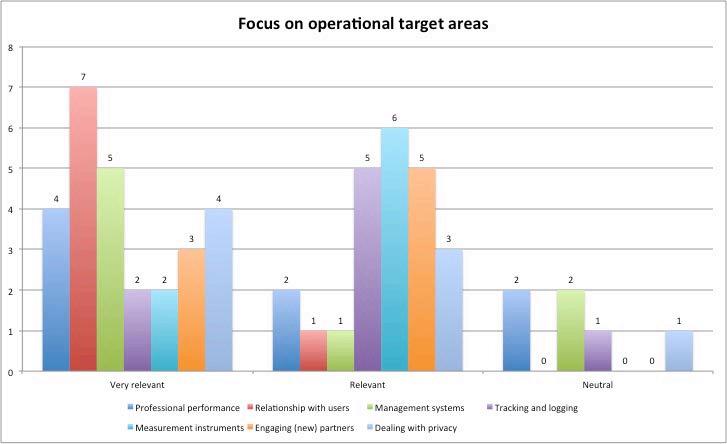
It is clear that such network should not only cover the very specific operational issues of Living Lab projects. The scope of such network would be much broader and focusing on the following aspects: • Connecting and collaborationwith stakeholders • Developingsector specific methodologies and services • Sharingdomain specific knowledge and experience • Networkingwith other Living Labs
Figure 11. Scope of the health domain specific network
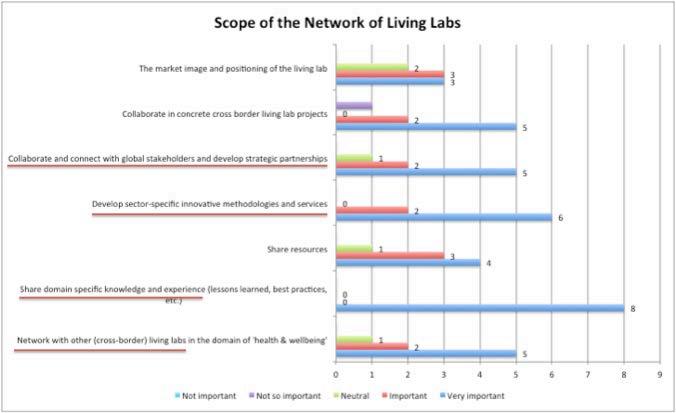
When looking what the network needs to do and be organized within the above scope, we do see two main elements. First of all the network should focus on the sharing of information. Thisknowledge sharingis on two levels: on the one hand information on andabout the Living Lab itself. What are they doing, how are they organized, what assets do they have…? On the other hand they want to share information on the projects that are being performed in the Living Lab. What type of projects, what are the results, who’s involved, how set-up…? Second, the network should also organize workshops in which not only this information can be shared, but also to tackle very specific issues that are important in the executionof health Living Lab projects. This can range from issues like privacy over user involvement to tools and methods that can be used.
Figure 12. Organizational aspects of the network

3.1.3 Summary When looking at the results of the survey, although the limited response rate, we do see some interesting elements. First of all it is acknowledge that there is a clear interest and necessity in a thematic network. All Living Labs confirmed that they would become a member of such initiative. This network should be organized within the structure of the European Network of Living Labs.Ideally this should be free of charge and open to all Living Labs.The topics that this network should focus on in the first place are, according the Living Labs, mHealth, and Ambient Assisted Living. The network itself can not only target operational issues but should especially focus on the exchange of information of specific health related topics and the sharing of Living Lab data . The survey reflects the vision of the Living Labs that are active in the domain itself. Their needs towards a cross-border network are mainly focused on their own type of organizationand the way to improve this.However, it is clear from the results of the cross-border pilots performed in APOLLON that the thematic network also should address and target other type of actors such as SMEs, public organizations and large companies.
3.2 Results from the pilot
Apollon –Deliverable D2.5 During the cross-border pilots in APOLLON andby so working in a cross-border networkenriched the Living Labs in their activities andfacilitated SMEs to enter foreign markets. The Living Labs discovered some new roles and act, in this cross-border setting much more as a facilitator of establishing a local ecosystem and providing access to local stakeholders. They are well positioned to do this in an easy and efficient way. Their neutral role offers them the necessary confidentiality and trust for different actors. The Living Labs specialized in Health, Homecare and Wellbeing have therefora clear role as both the test bed for innovation and as a central point in role of innovation intermediary.A thematic network of Living Labs do offer a platform in which they are easy accessible. Based on the experiences of the cross-border pilots in the domain of Health a number of specific elements–related to this domain –have been identified as crucial in the set-up of these types of pilots and in which a thematic network can play an active role. We list the following (these items are more elaborated in D2.4Evaluation and Recommendation) • Privacy: especially in health related collaborations and pilots is a crucial element. Next to EU regulation each country has specific rules to this in which you need not only a good guidance, but also access to those organisations that are in line with these rules. • Liability:for those projects in which more emergency alert services or medical related services or products are being tested, liability is of essence and the margin to experiment less flexible. Also here fall-back mechanism need to be in place. • Ethics:In health and well-being you not only work with specific user group but you also get in touch with very sensitive data. Exchange on how to deal with these data and the properprocedures are required • Local assessment:When facilitating cross-border collaboration a quick local assessment of the feasibility prior to the project is needed. A more thorough investigation can be performed afterwards. • Safety:That safety is an important point-of-attention seems obvious, but difficult part is that the strictness of the safety for the client is very different per country or even per care organization. The Living Lab can assess this and also investigate the possible impact. • Maturity& reliability:related to the previous element –it is, especially within the health domain required to work with stable, mature nd reliable services and products. The living lab can facilitate the necessary tests to make sure that it meets the standards. • Cost:the element of cost refers to the eco-system and the accompanying business model. Here the Living Lab can provide the necessary insights to either position a certain service or product in the right way or to make sure that it complies with the existing models.
Trust:Living Labs need to enhance trust on two levels: on the one hand between the different partners involved in a project and to the test-panel on the other hand Rules and regulations:Living Labs do not only guide partners in the specific rules and regulation to which a service has to comply, but they can also create and offer a test-environment that can bypass some of these to evaluate new innovative things for which current legislation is not adjusted Access to end-users:Living Labsarea crucial actor in identifying the right organisations that can fulfil the role of the trusted party and by so act as a gateway between the project and the end-usersto fulfil various aspects (getting user feedback, installing devices….)
Figure 13. Overview of critical elements in Health related cross-border pilots
